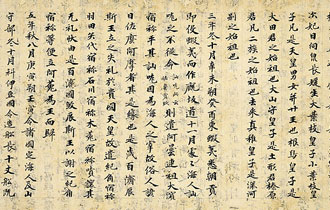Pages |
The feudal government issued directives to all classes from time to time to prohibit spending on expensive food and luxuries. Samurai were directed to eat frugally and merchants, who were more affluent than samurai toward the end of the Edo period, were also told to control their spending, even to the extent that they were told how many side dishes they could have in a meal (usually five dishes, in addition to rice, soup, and pickles). Ironically, although a vast majority of farmers were poor, some gained enormous wealth and began living in a life of luxury. Time and again, laws were promulgated against spending an exorbitant amount of money for the season's first catch of fish, in an attempt to curb Edoites' appetite for it. This did not have much effect. In 1686, the government issued a directive to set the date on which each of the various fruit, vegetables, and mushrooms could be marketed and, in 1742, another law determined when the first catch of fish could be sold.
Perhaps the most radical change in Japanese eating habits took place in the mid-nineteenth century. During this time, the long-held taboo against certain food and superstitions about food combinations gave away and, with the opening of the country and with foreigners bringing in a variety of new food and dishes (such as milk and butter), the people began to eat dairy products and the meat of animals and fowl. With an official lifting of sanction against meat eating, experimenting with red meat became something of a fashion, so much so that every townsman who embraced the motto of the time "Enlightenment and Civilization" caught onto this craze. Eating beef was just as fashionable as getting the male traditional topknot cut off. New food, such as the Irish potato, tomato, celery, cabbage, asparagus, and onion were introduced into the Japanese diet. Many food items whose roots date back from this time in history, transmuted to suite the Japanese taste, still persist today. These include ramune (from English 'lemonde'), korokke ('small breaded and fried potato patties with fillings' from French croquette), tonkatsu (fried and breaded pork cutlets, from Japanese ton, 'pork' + katsu 'cutlet'), omuraisu (ketchupped rice topped with an egg omelet, omu, from English 'omelet' + raisu, from English 'rice'), hayashiraisu (ground meat and rice cooked with ketchup, hayashi, from English 'hashed beef' + raisu English 'rice').
The Japanese diet again experienced a major change after World War II. Especially in the fast food sector, American influence was strongly felt and with this, certain changes in eating habits have taken place. Japan also contributed to fast food by inventing now ubiquitous instant noodles. For the last several decades, per capita consumption of rice has been slipping; this in contrast to increasing consumption of all types of vegetables, meat, diary, and wheat.
A concern for more healthful choice of food, especially among the young, has been expressed in the media. The Japanese continue to incorporate non-indigenous foodstuff from abroad, not to mention find ways to combine food in a variety of novel ways to appeal to the Japanese taste. For instance, pizza shops offer an enormous variety not imaginable in the United States; their current offering includes pizzas topped with, among other things, potato salad or green salad, fruit, barbecued pork, etc.
Pages |











